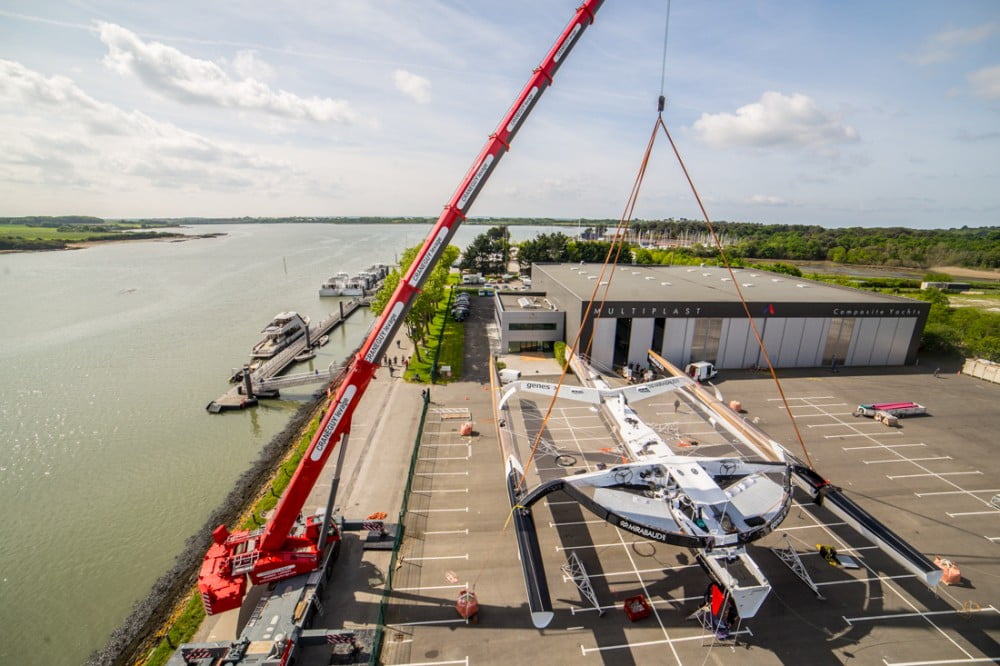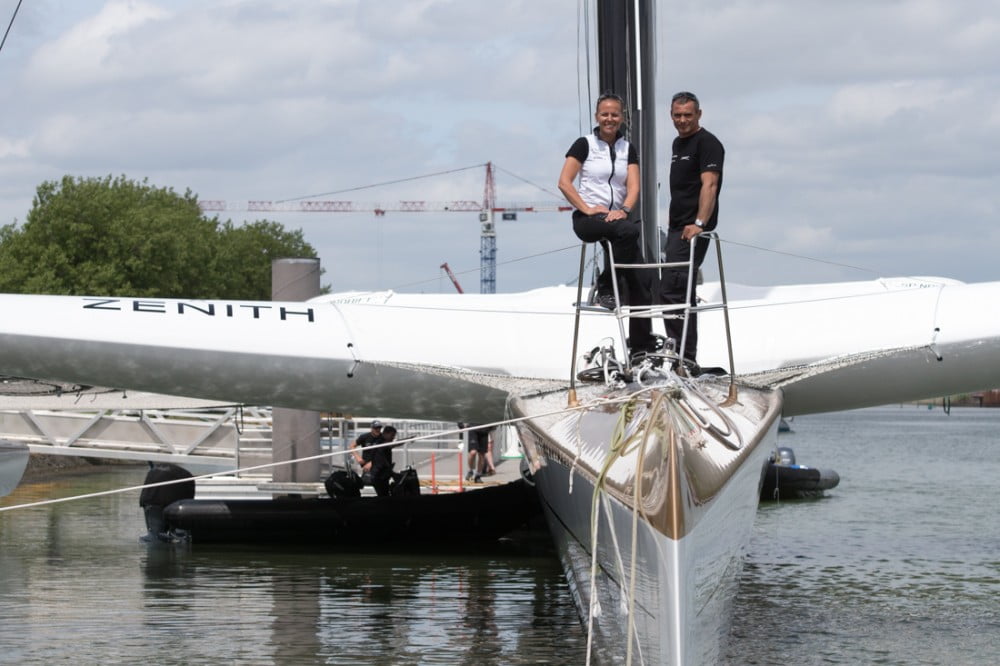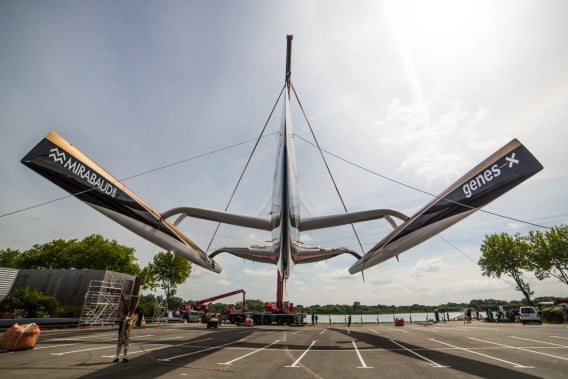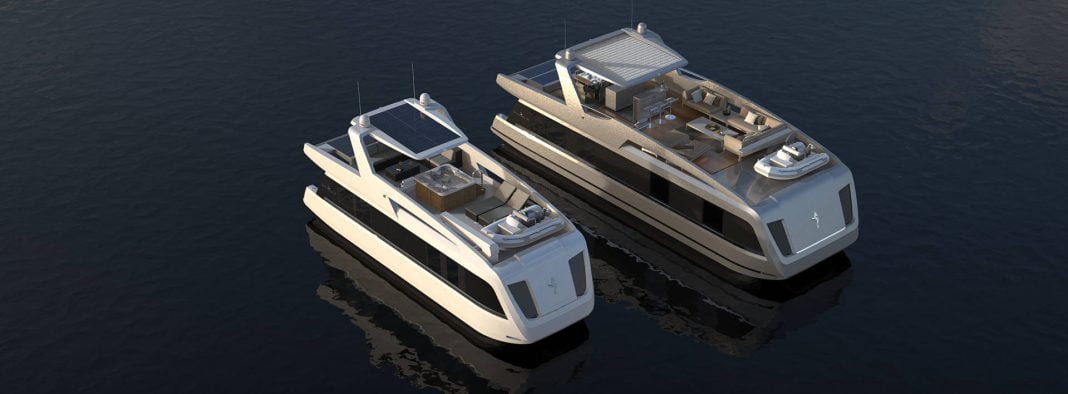The trimaran Spindrift 2 has been relaunched today in Vannes, following months of optimisation in preparation for the huge challenge of a new around-the-world record attempt during the winter of 2015-16.
Hours of meticulous planning, calculations, innovations and implementations carried out by the research and technical teams put together by Dona Bertarelli and Yann Guichard make this 2015 version of the largest racing trimaran in the world entirely the work of Spindrift racing.
The chassis has been improved and the engine entirely replaced, with a new 42-metre (and 25% lighter) mast and a new set of sails. Technology is in the DNA of Spindrift racing and the team has pulled out all the stops to optimise the boat. As a result, Spindrift 2 is now lighter in terms of both weight and handling.
This winter, Spindrift racing will take on the challenge of the Jules Verne Trophy, the crewed sailing record for circumnavigating the globe around the three capes, departing from Pointe Bretagne. To beating the current record of 45 days, 13 hours will require the best possible crew and a boat prepared specifically for the highly demanding and extreme course. Indeed, the initial reason for Spindrift racing’s decision to acquire this 40-metre maxi-trimaran was because the team believed that they could shave more time off the record, and that this high-performance prototype had potential for technological development.
“We wanted to build a team which could undertake our own technical and sporting challenges, and enable us to perform well and excel in what we do,” explained Dona Bertarelli. “We are very proud of what we have already achieved and are now excited to return to offshore sailing on Spindrift 2 in preparation for the Jules Verne Trophy.”
A brand new engine!
Spindrift 2 is a genuinely huge boat. For Yann Guichard, however, he believed she could be versatile and powerful and could fly through the air despite her size, which is why the Franco-Swiss team have made so many technical changes over the past two years. The hybrid version developed for solo racing at last year’s Route du Rhum was already a major step forward in that direction.

For the around-the-world race, the team needs a boat that has plenty of canvas in light winds, a boat that will be comfortable in the weather transitions and a boat that is able to step up the pace in the swell of the south and in strong winds, without having to reduce too much sail. “We’ve designed a slightly shorter mast than the original one. The structure has been optimised by our design team in conjunction with GSea Design,” explained Yann Guichard. “It was built to the highest standards at CDK Technologies in Europe’s longest autoclave (a 50-metre chamber). The part is half a tonne lighter, reducing the boat’s total starting weight by a quarter. Add this to the weight reductions made to the sails manufactured by North Sails, and to the rigging, and there is a tonne less weight at the top of the mast. This will give the boat more pure speed and better handling.”
The devil is in the detail
As part of this virtuous circle, several dozen kilos were shed from the deck: one of the original four coffee-grinders was removed, the hydraulic system was made more sleek, and the fittings inside the boat were stripped to the bare minimum. Everything was scrutinised. “For example, we have changed all of the bags for carrying equipment, boots, clothes and food. This alone has reduced the weight by 35 kg, equivalent to half the weight of a crew member,” explained the skipper, Yann Guichard.
He added: “We’ve established a technological partnership with the École Polytechnique Fédérale de Lausanne (EPFL), who are providing us with great potential in many different areas, including on-board power and hydrodynamics. We’ve already introduced some of the innovations to Spindrift 2. Finally, we’ve improved the boat’s aerodynamics. We extended the cover towards the rear of the cockpit, and replaced the nets with tarpaulin in places. To conclude, Spindrift 2 has taken on a new look as we have seek to improve performance wherever possible.”
Once stress tests have been conducted in the docks on the new mast, the team will soon begin to test-sail the boat. The focus will now turn to optimising performance, departing from La Trinité-sur-Mer. The trimaran will compete in the Fastnet Race in mid-August then, in October, the stand-by for the record will commence. It will be a question waiting for the best possible weather window to set off of an around-the-world record attempt.
Technical specifications:
Name: maxi-trimaran Spindrift 2
Central hull length: 40 m
Length of floats: 37 m
Beam: 23 m
Displacement: 21.50 t
Draft: 5.10 m
Air draft: 45 m
Mast height: 42 m
Mainsail: 405 m²
Gennaker max: 560 m²
Gennaker medium: 450 m²
Gennaker mini: 360 m²
Reacher: 260 m²
Staysail: 170 m²
ORC: 75 m²
Maxi-trimaran Spindrift 2 schedule:
May – end July
Training aboard Spindrift 2.
Fastnet race (August 16th, 2015)
The 46th edition of a great British sailing institution. The 605-mile Fastnet race will take place on the animated waters to the south-west of the British Isles. The course runs from Cowes, the home of British sailing, along the coastline of southwest England, around Fastnet Rock, off the coast of Ireland, and then on to Plymouth via the Isles of Scilly.
September – October
Training aboard Spindrift 2.
Jules Verne Trophy
Around-the-world record attempt starting from Ouessant Island (Brittany, France) and circumnavigating the world, passing Cape of Good Hope, Cape Leeuwin and Cape Horn to port. The current record was set on January 6th, 2012 by the maxi-trimaran Banque Populaire V (Loïck Peyron and thirteen crew members) in a time of 45 days, 13 hours, 42 minutes and 53 seconds, averaging 19.75 knots.
Spindrift racing agenda
*Yann Guichard finished second in the Route du Rhum – Destination Guadeloupe 2014, sailing single-handed aboard Spindrift






